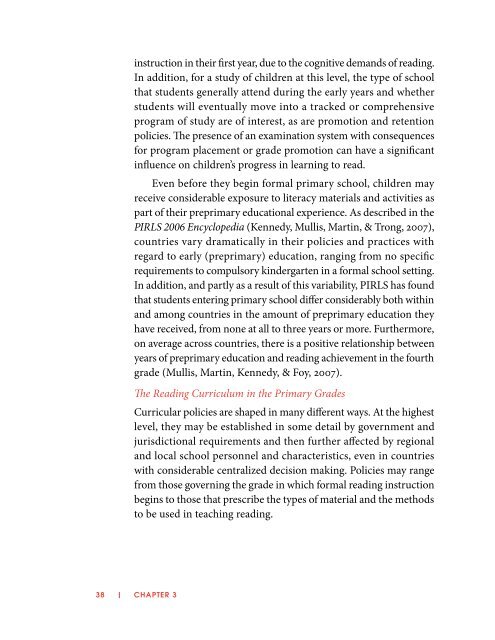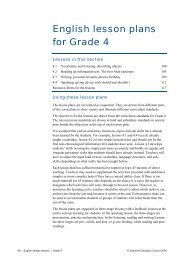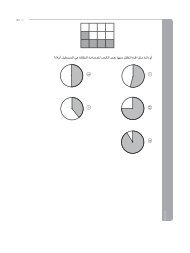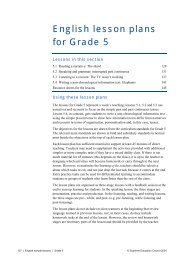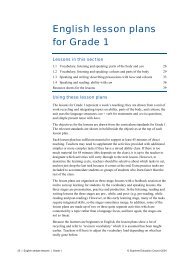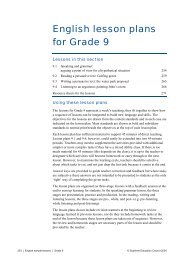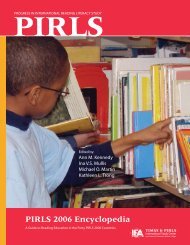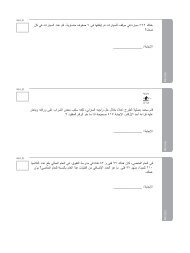instruction in their first year, due to the cognitive demands of reading.In addition, for a study of children at this level, the type of schoolthat students generally attend during the early years and whetherstudents will eventually move into a tracked or comprehensiveprogram of study are of interest, as are promotion and retentionpolicies. The presence of an examination system with consequencesfor program placement or grade promotion can have a significantinfluence on children’s progress in learning to read.Even before they begin formal primary school, children mayreceive considerable exposure to literacy materials and activities aspart of their preprimary educational experience. As described in the<strong>PIRLS</strong> 2006 Encyclopedia (Kennedy, Mullis, Martin, & Trong, 2007),countries vary dramatically in their policies and practices withregard to early (preprimary) education, ranging from no specificrequirements to compulsory kindergarten in a formal school setting.In addition, and partly as a result of this variability, <strong>PIRLS</strong> has foundthat students entering primary school differ considerably both withinand among countries in the amount of preprimary education theyhave received, from none at all to three years or more. Furthermore,on average across countries, there is a positive relationship betweenyears of preprimary education and reading achievement in the fourthgrade (Mullis, Martin, Kennedy, & Foy, 2007).The Reading Curriculum in the Primary GradesCurricular policies are shaped in many different ways. At the highestlevel, they may be established in some detail by government andjurisdictional requirements and then further affected by regionaland local school personnel and characteristics, even in countrieswith considerable centralized decision making. Policies may rangefrom those governing the grade in which formal reading instructionbegins to those that prescribe the types of material and the methodsto be used in teaching reading.38 | Chapter 3
Curricular aspects and governing policies particularly relevant tothe acquisition of reading literacy include standards or benchmarksestablished for reading development, prevalence of school andclassroom libraries, instructional time, methods and materials, andways of identifying students in need of remediation. Considerableresearch evidence, including results from IEA studies (Kennedy,Mullis, Martin, & Trong, 2007; Mullis, Martin, Kennedy, & Foy,2007), indicates that students’ academic achievement is closelyrelated to the rigor of the curriculum. This involves a coherentprogression of instruction and materials through the grade levels,including emphasis on decoding and comprehension strategies,and access to a variety of reading materials. Effective methods fordisseminating the curriculum to teachers, parents, and the generalpublic are important, as are as ways for making sure that revisionsand updates are integrated into instruction.Delivering a coherent and rigorous curriculum is dependent onwell-qualified teachers. Research has established the importance ofteachers being prepared in the subject matter they teach and of theircertification status (Wayne & Youngs, 2003). The requirements tobecome a primary teacher may include certain types of academicpreparation, passing an examination, or meeting other certificationcriteria. Some countries also have induction or mentoring programsfor entering teachers and a number of opportunities for ongoingprofessional development to keep teachers apprised of currentdevelopments.Home ContextsMuch research has provided insight into the importance of homeenvironments for children’s reading literacy. Long before childrendevelop the cognitive and linguistic skills necessary for reading, earlyexperiences with printed and oral language establish a foundationfor learning (Adams, 1990; Ehri, 1995; Verhoeven, 2002). ParticularContexts for Learning to Read | 39
- Page 1: PIRLS 2011 AssessmentFrameworkIna V
- Page 4 and 5: PIRLS 2011 Assessment Frameworkby I
- Page 7 and 8: ForewordCentral to a nation’s pur
- Page 9: number of people. I would like to e
- Page 13 and 14: Chapter 1Overview of IEA’s PIRLS
- Page 15 and 16: prePIRLSPIRLS 2011 has been extende
- Page 17 and 18: the assessment (Campbell, Kelly, Mu
- Page 19 and 20: communities outside of school as st
- Page 21 and 22: A substantial proportion of the que
- Page 23: PIRLS Reading Purposesand Processes
- Page 26 and 27: each purpose. Although the assessme
- Page 28 and 29: character, or there may be several
- Page 31 and 32: information requires that the reade
- Page 33 and 34: Interpret and Integrate Ideas and I
- Page 35: Reading tasks that may exemplify th
- Page 40 and 41: likely influence home environments
- Page 42 and 43: and the mechanisms it can establish
- Page 46 and 47: home characteristics can create a c
- Page 48 and 49: need to reach out to inform, encour
- Page 50 and 51: As an instructional leader, the sch
- Page 52 and 53: Parental InvolvementThe success of
- Page 54 and 55: effective teachers continue to acqu
- Page 56 and 57: Instructional Materials and Technol
- Page 58 and 59: of the two. The amount of homework
- Page 60: to participate in such activities.
- Page 65 and 66: Chapter 4Assessment Design and Spec
- Page 67 and 68: prePIRLS assessment consists of six
- Page 69 and 70: In PIRLS 2011, similar to PIRLS 200
- Page 71 and 72: Figure 4PIRLS 2011 Student Booklet
- Page 73 and 74: Each multiple‐choice question is
- Page 75 and 76: approximately seven multiple-choice
- Page 77 and 78: Figure 6prePIRLS 2011 Student Bookl
- Page 79 and 80: Learning to Read Survey (Home Quest
- Page 81: References
- Page 84 and 85: Baker, L., Dreher, J.J., & Guthrie,
- Page 86 and 87: Ehri, L. (1995). The emergence of w
- Page 88 and 89: Kamil, M.L., Intrator, S.M., & Kim,
- Page 90 and 91: Miller, S. D., & Faircloth, B. S. (
- Page 92 and 93: Scarborough, H.S. (2001). Connectin
- Page 94 and 95:
Weaver, C.A., & Kintsch, W. (1996).
- Page 96 and 97:
Hameedy, M.A. (2004, May). Bilingua
- Page 98 and 99:
Netten, A., Verhoeven, L., & Droop,
- Page 101:
Appendix AAcknowledgements
- Page 104 and 105:
specifically acknowledge some of th
- Page 106 and 107:
PIRLS 2011 Questionnaire Developmen
- Page 108 and 109:
CanadaPierre BrochuCouncil of Minis
- Page 110 and 111:
LuxembourgPierre RedingMinistère d
- Page 113 and 114:
Appendix BSample PIRLS Passages,Que
- Page 115 and 116:
Anina could not believe her eyes as
- Page 117 and 118:
She could hardly believe what happe
- Page 119 and 120:
QuestionsAn Unbelievable Night****C
- Page 121:
***Correct answersAmple PIRLS Passa
- Page 124 and 125:
Scoring Guides for Constructed-resp
- Page 126 and 127:
Unbelievable Night, Item 11You lear
- Page 128 and 129:
122 | Appendix B
- Page 130 and 131:
Follow an Ant TrailAnts live togeth
- Page 132 and 133:
Make a WormeryWorms are hard to stu
- Page 134 and 135:
QuestionsSearching For Food***Corre
- Page 136 and 137:
**Correct answer130 | Appendix B
- Page 138 and 139:
132 | Appendix B
- Page 140 and 141:
Scoring Guides for Constructed-resp
- Page 142 and 143:
Searching for Food, Item 11Number t
- Page 145 and 146:
Appendix CSample prePIRLS Passage,Q
- Page 147 and 148:
1. Where was Charlie at the beginni
- Page 149 and 150:
3. Write two things that Charlie di
- Page 151 and 152:
7. What did Charlie see a flyer for
- Page 153 and 154:
10. How can you tell that Dave’s
- Page 155 and 156:
15. What did Charlie keep looking f
- Page 157 and 158:
Charlie’s Talent, Item 5What were
- Page 159:
Charlie’s Talent, Item 10How can


